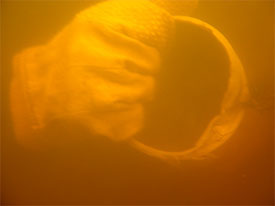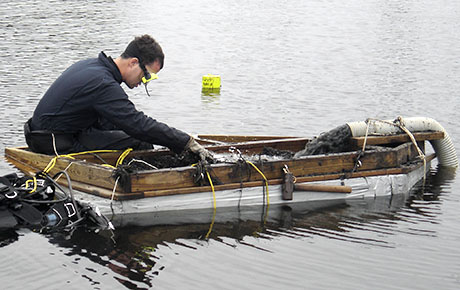ECU's 2006 Fall Field School
Project Journal
13 September 2006
By Adam Friedman

Wednesday...Wednesday the 13th. The day started like any other; a cool, slight breeze, and a lot of mud to suck away from Vessel 1. As Amy described in yesterday's we have had numerous problems with the dredge: underpowered pump engines, overly long intake and spoil hoses, and issues of clogging. After switching to a larger pump engine, one capable of moving 208 gallons per minute, we were optimistic on the ride across the river to our site.
We prepared the engine, attached all hoses, and tied down the dredge head to a stake driven into the soft muds the depth of which is unknown (China has been the best guess yet proposed). It was decided that I would not be the first on the dredge. That honor was mine yesterday and, during that trial with the dredge, the hose clogged irreparably. Misfortunes surrounding the dredge, such as engine cut-outs, clogs, and other problems, always seemed to occur on my watch. Apparently I am bad luck. Anyway, Trish needed experience on the dredge as well, and so she continued where yesterday's work left off.

Underwater photo of student's hand holding the dredge. (Yes it really looks like that in a North Carolina river)
Despite the problems of yesterday, an area around the suspected stern post was cleared of mud. The objective for today was to continue removing this mud until reaching the keelson, at which time dredging would continue along the keelson to the centerboard assembly. "Elementary!" we cried. "Prepare to be moved!" we taunted the mud. "Horsefeathers!" retorted the dredge pump.
The dredging went perfectly, at first. Trish cleared a large area down to the ceiling planking, which is in a high state of preservation, between the stern post and the frame furthest aft. After her 30 minutes were up, she passed the torch to me. At a new personal best, nothing catastrophic occurred before 25 minutes, at which time a clog formed, reducing suction to almost nothing. It seemed that the pump had won again. An additional 20 minutes was spent trying to find the clog but failing that, we turned the pump on again. Low and behold, the act of starting dislodged the clog, a plastic bottle, and dredging began again. I passed off the intake hose to Amy and returned to the boat with reputation intact.
Amy, and Joe after her, made considerable progress during their rotations, exposing the keelson to, and past, the frame furthest aft. The progress was so great that it required repositioning of the dredge head to allow the intake hose to reach points further forward along the keelson. Repositioning the dredge head also required moving the floating screen used to catch the dredge spoil. Since the screen sits about a half foot above the water, it had been tied to the side of the barge, allowing for someone to lie on the deck and check the screen contents as they spilled out of the spoil hose. Now away from the barge, the screen posed a logistical problem: how can a person in the water effectively attend the screen? Simple. I affixed my dive gear to a tow rope attached to the screen and hopped onto the side where there was a 1.5 ft x 1.5 ft. space, existing only to provide an attachment point for the floatation foam beneath it. The screen, or Huck Finn's raft as I renamed it, adequately held my weight and proved quite comfortable!

Adam sits on "Huck Finn's Raft" and sifts through the dredge spoils.
By this time, the afternoon was growing late and, like all good things, the workday eventually came to an end. Today, we troubleshooted what we hope to be the last of the dredging problems and cleared a significant portion of Vessel 1 of mud. As long as no errant plastic bottles are encountered, I am optimistic of continued progress tomorrow.
For more information you can visit the ECU website at:
http://www.ecu.edu/maritime/index.htm
Return to Project Journal home page.

